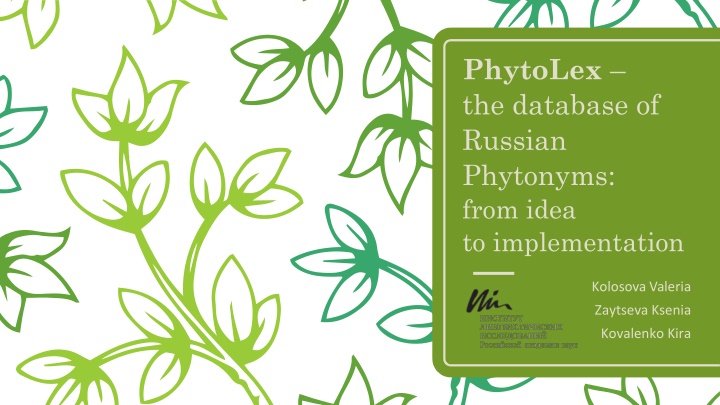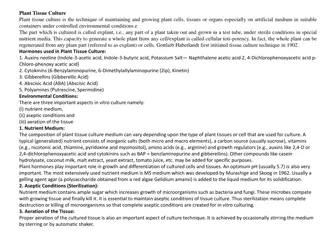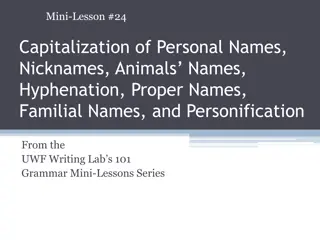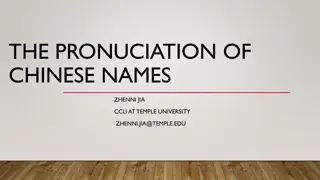Uncovering Russian Plant Names: PhytoLex Database Project
The PhytoLex database project aims to collect and analyze Russian plant names from historical texts, shedding light on their origins, meanings, and cultural significance. By exploring old manuscripts and dictionaries, the project seeks to bridge gaps in knowledge and enhance understanding of plant names through a historical lens.
Download Presentation

Please find below an Image/Link to download the presentation.
The content on the website is provided AS IS for your information and personal use only. It may not be sold, licensed, or shared on other websites without obtaining consent from the author.If you encounter any issues during the download, it is possible that the publisher has removed the file from their server.
You are allowed to download the files provided on this website for personal or commercial use, subject to the condition that they are used lawfully. All files are the property of their respective owners.
The content on the website is provided AS IS for your information and personal use only. It may not be sold, licensed, or shared on other websites without obtaining consent from the author.
E N D
Presentation Transcript
PhytoLex the database of Russian Phytonyms: from idea to implementation KolosovaValeria Zaytseva Ksenia Kovalenko Kira
Purposes of the project to collect plant names mentioned in the Russian text from 11thto 17thcenturies supply plant names with contexts describing their outlook, functions and legends, connected with them identify unknown Russian plant names find out the time and ways of borrowing (for loanwords), changes in their spelling and meaning
Why is it necessary? Historical corpora Historical sub-corpus in the National corpus of the Russian language (http://ruscorpora.ru) Manuscript (http://www.manuscripts.ru) Corpus Cyrillo-Methodianum Helsingiense (http://www.helsinki.fi/slaavilaiset/ccmh/) Old Slavonic Corpus of the University of South California (http://www-bcf.usc.edu/~pancheva/HistoricalSyntaxSouthSlavic.html)
Why is it necessary? Historical corpora http://ruscorpora.ru/search-old_rus.html
Why is it necessary? Historical dictionaries Sreznevsky I.I. Materials for a Dictionary of the Old Russian Language. Vol. 1-3. 1893-1912. A Dictionary of the Old Russian Language of the 11th-14thCenturies]. 1988-. A Dictionary of the Russian Language of the 11th-17thCenturies]. 1975-. A Dictionary of Quotidian Russian of Muscovite Russia of the 16th-17th Centuries. 2004-. Etymological dictionary of Slavic languages. Proto-Slavic lexical stock]. 1974-. some regional historical dictionaries
Why is it necessary? Lacunae in the historical dictionaries Etymological dictionary Modern Russian language of Slavic languages *baran c > *bedren c > *gorikv t > *gor c >
Why is it necessary? Late time of the first occurring in text (oak) 12thc. , (orach) 13thc. (birch) 15thc. (maple) 15thc. (henbane) 16thc. (aloe) 17thc. (blueberry) 17thc. , (elecampane) 17thc.
Why is it necessary? Insufficient semantisation [SlRL XI XVII 5: 86] zheltyanika a name of a plant [SlRL XI XVII 8: 61] krovatnik a name of the herbaceous plant [SlRL XI-XVII 4: 351] drachie a name of a medicinal plant
Why is it necessary? Insufficient semantisation: , . . ; . .1, 88 . XVII . [ . XI-XVII ., . 5, . 369]. Zelenichie, neutral. Name of an evergreen tree. Zelenichie is a tree so called because it has green leaves both in summer and in winter and its leaves are like those of blueberry. Azbukovnik, 88r, 17thc.
Why is it necessary? , , , { } ( . , Q.XVI.20, .91) Zelenichie is a tree which has green leaves both in summer and in winter and its leaves are like those of blueberry (Grammar book). Lavrentiy Zizaniy s Lexicon < Bible, Isaiah book 41:19 boxtree, Buxus sempervirens
Research group Head: Kolosova Valeria Members of the project: Molkov Georgy Ippolitova Alexandra Olekhnovic Olga Khudin Kirill Kovalenko Kira Schekin Alexey Zaytseva Ksenia
Research group Head: Kolosova Valeria Members of the project: Old Russian texts (11th-15thc.) herbal books documents of the Apothecary Chancery handwritten lexicons historical documents technical implementation Molkov Georgy Ippolitova Alexandra Olekhnovic Olga Khudin Kirill Kovalenko Kira Schekin Alexey Zaytseva Ksenia
Technical implementation Database: PostgreSQL Django framework (Python) Javascript (leaflet js for geovisualization) HTML, CSS
Controlled vocabularies - SKOS Each term is modeled as skos:Concept List of terms is modeled as skos:Collection All terms are in one skos:ConceptScheme Hierarchical lists (3 levels) - Function (168 concepts) - Genre (55 concepts) Flat lists - - - Medicinal form (28 concepts) Plant part (30 concepts) Translation method (9 concepts)
Search options plant names of a particular period plant names of a particular text or genre plant names for the same plant citations with plant description citations with etiological legend plants gown or bought in specific regions source languages of borrowing and others
Main challenges Preface to the Russian handwritten lexicon i , : , , , , , , i , , , , <...> i , , , , . Also, unskillful authors write other many words corruptedly and not in God s way, because they write in the Ladder [of Divine Ascent], in the word to a priest, like that: beware like of some eres (heresy), and one should write eresiva (honeydew), not eres (heresy), not knowing that eres is not eresiva, for eres is not believing and eresiva is a herb, and its seed, being in wheat, makes the wheat bread black < > Also unskillful authors write in the Ladder kedry (cedars) instead of kitry (citron-tree), understanding, what kedry are and what kitry are.
Main challenges Data modelling Plant names identification: unknown semantic wrong spelling: > * > > * > > * >
First discoveries Literary sources of the Russian handwritten lexicons entries , , , (!). , , // , . , , , , . , . { . . , .} ( . Q.XVI.20, . 120 . - 121). Kitra (kind of lemon) is a large berry looking like a melon, it has sour taste and is related orange. The tree is not big, smaller than cherry tree, and when it brings fruit, it is tied to the tree-top // and bend the tree-top to the ground, and so they bring good fruit. If the top had not been bent the fruit would not have ripened, but would have fallen down while still green. These kitras the author of the Ladder mentions in a fable about humility in chapter 25 of his book (Life of Onuphrius the Great, Tale about the Saint mount Athos).
First discoveries Literary sources of the lexicons entries The Tale about Saint mount Athos i i : ... , , ; , ; , , ; , , [ 1882: 23] Ladder of Divine Ascent of John the Climacus , , 25 , , : i . . i . ( , . 304.I, . 136 .);
First discoveries A dictionarie of the vulgar Russe tongue: attributed to Mark. Ridley ed. from the late-sixteenth-century manuscripts and with an introd. by Gerald Stone. Koln; Weimar; Wien, 1996 . Asaru[m]. supposingly, Asarum europaeum L. . populus. Populus L., includes various types of poplars and also aspen. But Russian name allows to suggest that it is alder-tree (compare dialect names: , , , , , , , , )
Further development A dictionary of the Russian plant names Database development Dialect plant names East Slavonic plant names Crowd sourcing
Thank you for your attention!























